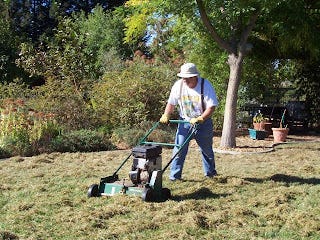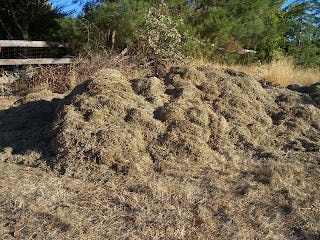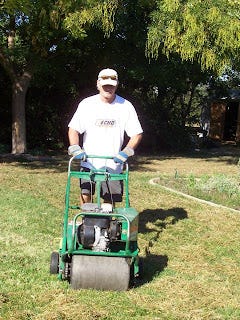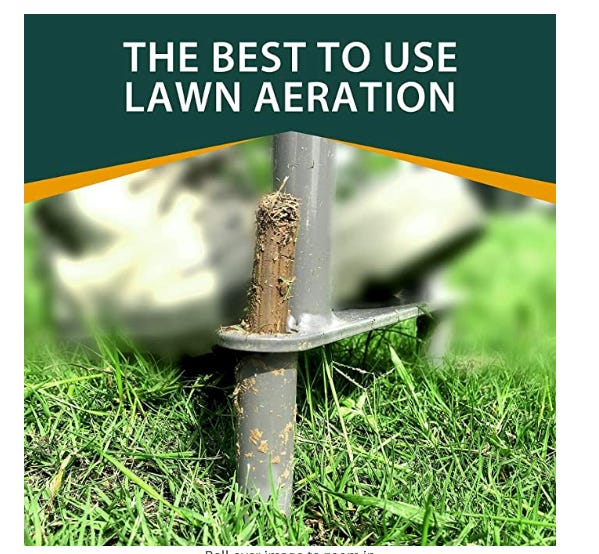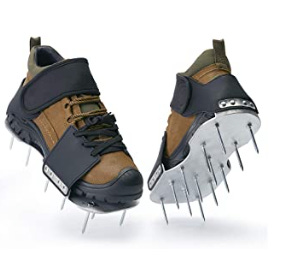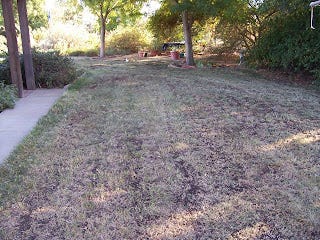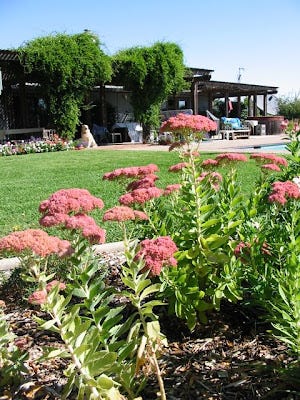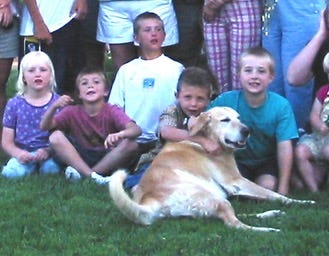Fall Lawn Rehab Tips.
Now's the time to get your lawn back to better health, and you can do it organically.
Episode 139 of the Garden Basics with Farmer Fred podcast is available now, wherever you get your podcasts, including right here. We delve in to fall lawn care in this episode, with Organic Landscaping professional Steve Zien of Living Resources Company. Although retired now, Steve is staying active in the organic education field.
Frankly, the application of combination products that contain fertilizer and herbicides for weed control in your lawn scare me. It can have unwanted consequences for nearby plants as well as your lawn, if you are not sure of your turf grass variety. As I am fond of saying, “read and follow all label directions”. And if you studied a so-called “weed n feed” product label carefully, you just might think twice about using it on your lawn. Here’s a portion of one such label. Just a portion, mind you.
If you want to fertilize your lawn, just get a fertilizer-only product. If you want to rid your lawn of weeds, dig ‘em out with a tool like one of these.
On the latest Garden Basics podcast, we talk about how a healthy lawn, properly cared for, can thwart future weeds.
Also on the podcast: Warren Roberts, Superintendent Emeritus of the UC Davis Arboretum, has a prolific spring-summer-fall blooming perennial as the Plant of the Week, the Gaillardia.
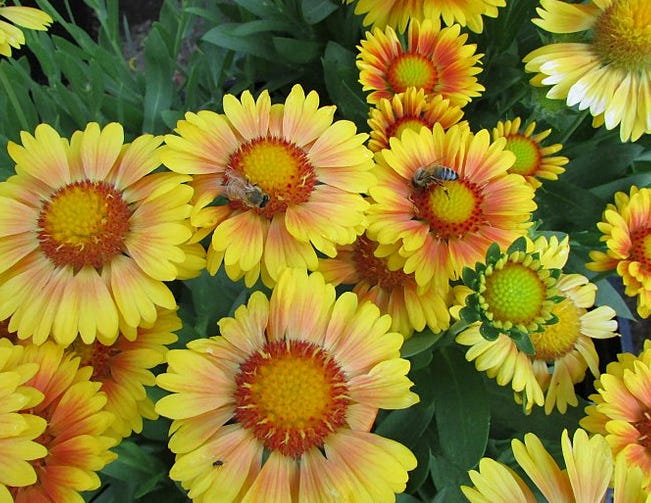
A Healthy Lawn Uses Less Water. Here’s What to Do, Now
In the County of Sacramento, California, as in many other Western locales, watering a lawn every day is no longer an option, due to the drought. Throughout the West, water shortages abound. Ordinances throughout California currently mandate a maximum of three days a week for landscape irrigation…or less.
And the response by some homeowners? "If I don't water my lawn every day, it turns brown!" I hear this far too often from listeners.
There are a lot of possible culprits for this scenario: compacted or poor soil, slow drainage, the wrong turf type for the area, sloping lawns, uneven coverage by sprinklers and more.
The biggest culprit in lawn problems? Watering a lawn every day. Daily, light irrigations causes lawn roots to remain near the surface, where they are more susceptible to damage from heat, cold, animals, disease, etc.
And those lawn roots may not be getting much water, because of thatch buildup.
According to the UC Guide to Healthy Lawns, thatch is the layer of living and dead stems, roots, stolons, and rhizomes between the green blades of grass and the soil surface. A thin layer of thatch (less than 1/2 inch thick) can be beneficial to the lawn because it helps to limit weed germination, reduce water evaporation, and protect the lawn from frost damage. However, thick thatch layers can prevent water, air, and nutrients from penetrating the soil, causing reduced root growth and increased potential for drought stress. Thatch also favors fungal growth and can harbor insect pests. Some turfgrass species, such as bermudagrass, bentgrass, and Kentucky bluegrass, have creeping growth habits and rapidly build thick thatch layers. But even the popular fescue varieties of lawn can build up a thick layer of thatch, even though the grass is green on the surface.
If you haven't dethatched your lawn in three years or more, September through mid-October is the time to not only dethatch, but to also aerate, fertilize and overseed your lawn in USDA Zone 9.
If more than 40% of your lawn is in really bad shape, then consider a complete lawn renovation in September or early October here in the mild winter areas of California. In other parts of the country, spring is the best time for this makeover. A complete lawn renovation involves removing all the existing turf, improving the soil and reconfiguring the sprinkler system to better cover the entire area (using lower flow sprinklers, such as the Hunter MP Rotators), as well as choosing the right turf type for your area. Directions for a complete renovation can be found here.
A partial lawn renovation involves uprooting thatch, aerating the soil, overseeding the lawn area and applying a thin layer mulch to maintain a healthy lawn throughout the coming year.
The first step is to cut your lawn as short as possible. Then, water your lawn thoroughly to soften the soil. Wait a day or two. Then bring on the necessary components: a dethatcher, aerator, starter fertilizer, compost for mulch, lawn seed, drinks and snacks. After all, if you've worked in the yard all day, who'll have the energy to run to the store for refreshments?
The dethatcher can be as simple as an iron rake or as complex as a power dethatcher or vertical mower, available at rental yards. You could buy a power dethatcher…if you’re trying to find fall and spring income opportunities for the household teenagers. Thatch - layers of dead grass - impede the movement of water and fertilizers to the root zone of a lawn and should be removed every two or three years. Don’t do it more often than that. Dethatching is major surgery for a lawn.
During the dethatching process, you may be in for a rude awakening. See that pile of thatch, above? It's about two cubic yards. That's what we removed from about 4000 square feet of what looked to be an otherwise healthy lawn. You can't see thatch when it's just below the lawn's surface!
After dethatching, remove the dead grass and then aerate the lawn area. An aerator, a device with sharp, hollow tubes, removes soil cores that are three to four inches deep. Aeration relieves soil compaction, allowing air, water and fertilizer to pass more freely through the soil, stimulating root growth. Hand aerators are available, but rented roller or power-driven aerifiers do the job more quickly and effectively, albeit more expensively.
This is what a hand aerator looks like, up close. As you can see, it consists of hollow tubes that pull up plugs of soil, which are ejected when you plunge the aerator into the next spot.
On the other hand, the shoes below are NOT AERATORS. Shoe spikes compact the soil. Hollow tubes aerify the soil.
Then, spread starter fertilizer and a lawn seed that closely matches your existing grass over the area. However, for Bermudagrass lawns, overseed with an annual or perennial ryegrass; this will keep your lawn green during the winter and spring while the Bermuda grass is brown and dormant.
After overseeding, press the seed into the ground with a water-filled roller, or rake the seed lightly to make sure it is in contact with the soil. Finish up by spreading a thin layer of compost over the entire area with a rolling spreader.
Keep the reseeded lawn area moist; the new seeds will sprout in seven to ten days. This is the ONLY time you need to water a lawn every day, keeping the seedbed evenly moist until the grass is up and growing. You may need to get permission from your local water agency to lightly water your new lawn every day.
Then, set your sprinklers to come on for a period of time that's appropriate for the weather: two or three times a week during the hottest months; once a week during the cooler months when it doesn't rain. And turn off the system entirely during the rainy season. Newer irrigation control systems will do that for you.
After dethatching, aerating and overseeding, your lawn will look absolutely terrible.
Do not fear.
By Thanksgiving, you will have the greenest lawn on the block!
And now that you have the greenest lawn on the block, some tips for keeping it healthy, organically:
• MOW AT THE CORRECT BLADE HEIGHT. Grass survival depends on having adequate leaf surface for food production through photosynthesis. Mowing too low removes too much of the food producing area. As the grass literally starves, the lawn thins and looks poor. Mowing too high can hurt the appearance or usefulness of the turf. The mowing height depends on the variety of turf grass. A guide.
• Organic lawn fertilizers contain no herbicides, unlike some synthetic ‘weed n feed’ products. And because they interact with the soil at a much slower rate, you don’t have to apply as often with an organic lawn fertilizer. Read and follow all label directions on any fertilizer you use. Remember: when it comes to fertilizers, more is not better.
• Walk your lawn several times a week. Look for trouble. Brown spots? Check your sprinklers for proper coverage. A healthy, thriving lawn thwarts weeds. When weeds appear, dig them up by hand before they can flower or spread.
Thanks for Subscribing and Spreading the Word About the Garden Basics with Farmer Fred newsletter, I appreciate your support.
And thank you for listening to the Garden Basics with Farmer Fred podcast! It’s available wherever you get your podcasts. Please share it with your garden friends.
As an Amazon Associate, I earn from qualifying purchases from some of the underlined links in the newsletter. This is how I am trying to keep this a free newsletter. And as long as you buy whatever you want from Amazon using any of those links to get into the Amazon site, I get a few pennies. Thank you.




